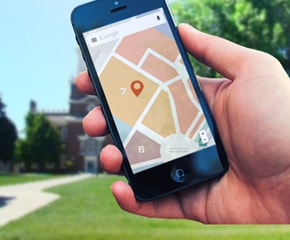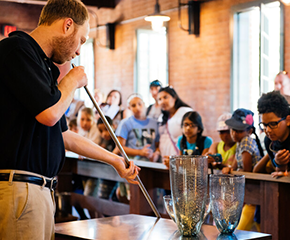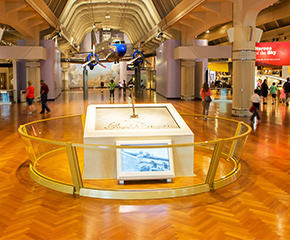
Dan Rubin Automotive Photographs
The Dan Rubin automotive photographs collection contains photographic prints, negatives, and slides documenting automobiles and automobile racing, primarily from 1952 to 1967.
Biographical / Historical Note
Dan Rubin was a noted New York photographer whose career took him around the world shooting his subjects. After majoring in photography at the New York High School of Art and Design, Rubin joined the Army Signal Corps during World War II, documenting...
MoreDan Rubin was a noted New York photographer whose career took him around the world shooting his subjects. After majoring in photography at the New York High School of Art and Design, Rubin joined the Army Signal Corps during World War II, documenting troops in France and Germany. After his time in the military, Rubin attended the Rochester Institute of Technology in New York to further his photographic knowledge. He became a well-respected photographer based in New York City, with a varied client base. He was the official photographer for the New York Giants during the 1960s. Rubin also shot advertising images for companies such as Alfa Romeo and Jaguar. Additionally, Rubin was known for his pictures of race cars and races, including those at Daytona, Indianapolis, and LeMans.
- Biographical information from "Photography’s New Breed," a pamphlet reprinted from U.S. Camera and Travel, February 1965 (included in this collection under Articles From Magazines and Pamphlets, Folder 1 of 3, Box 1).
LessScope and Content Note
The Dan Rubin automotive photographs collection (3 cubic ft.) contains photographic prints, negatives, and slides related to his work from the 1950s to the 1970s. Of the almost 10,500 images, many are of automobiles produced by Austin-Healey, Jaguar,...
MoreThe Dan Rubin automotive photographs collection (3 cubic ft.) contains photographic prints, negatives, and slides related to his work from the 1950s to the 1970s. Of the almost 10,500 images, many are of automobiles produced by Austin-Healey, Jaguar, MG, and Rolls Royce. Of special note are his photographs related to testing at the Bonneville Salt Flats, the Indianapolis 500, the Pierre Levegh accident at the 1955 24 Hours of Le Mans, and the 1961 Mickey Thompson Speed Runs at March Air Force Base (A.F.B.).
The materials are arranged alphabetically by subject, then chronologically within each subject.
LessCollection Details
Object ID: 2010.37.0
Creator: Rubin, Daniel R.
Inclusive Dates: 1952-1997
Bulk Dates: 1952-1967
Size: 3 cubic ft. (8 boxes)
Language: English
Collection Access & Use
Item Location: Not Currently On Exhibit
Access Restrictions: The photographs are open for research.
Credit: From the Collections of The Henry Ford.
Digitized Artifacts From This Collection
In many cases, not all artifacts have been digitized.
Contact us for more information about this collection.
MG Sports Car Driving at Bonneville Salt Flats, Utah, circa 1950
Artifact
Slide (Photograph)
Summary
In the 1930s, land speed racers everywhere began to flock to a landscape seemingly custom made for their sport: Utah's Bonneville Salt Flats. The hard, white salt provided a smooth running surface while the 46 square miles of open space offered plenty of room to speed up and slow back down. Typically, speed records were based on the average over an out-and-back run.
Creators
Object ID
2010.37.7
Credit
From the Collections of The Henry Ford.
Location
By Request in the Benson Ford Research Center
Get more details in Digital Collections at:
MG Sports Car Driving at Bonneville Salt Flats, Utah, circa 1950
What is The Henry Ford?
The national attraction for discovering your ingenuity while exploring America’s spirit of innovation. There is always much to see and do at The Henry Ford.
Ferrari Factory, Modena, Italy, 1953-1975
Artifact
Slide (Photograph)
Creators
Keywords
Object ID
2010.37.18
Credit
From the Collections of The Henry Ford.
Location
Not on exhibit to the public.
Get more details in Digital Collections at:
Ferrari Factory, Modena, Italy, 1953-1975
What is The Henry Ford?
The national attraction for discovering your ingenuity while exploring America’s spirit of innovation. There is always much to see and do at The Henry Ford.


Stirling Moss, Carroll Shelby, Masten Gregory, Pedro and Ricardo Rodriguez, John Fitch, Ernie Erickson at Nassau, Bahamas,1957
 Details
Details
Stirling Moss, Carroll Shelby, Masten Gregory, Pedro and Ricardo Rodriguez, John Fitch, Ernie Erickson at Nassau, Bahamas,1957
Artifact
Photographic print
Creators
Keywords
Object ID
2010.37.8
Credit
From the Collections of The Henry Ford.
Location
By Request in the Benson Ford Research Center
Get more details in Digital Collections at:
Stirling Moss, Carroll Shelby, Masten Gregory, Pedro and Ricardo Rodriguez, John Fitch, Ernie Erickson at Nassau, Bahamas,1957
What is The Henry Ford?
The national attraction for discovering your ingenuity while exploring America’s spirit of innovation. There is always much to see and do at The Henry Ford.
Carroll Shelby at Bonneville Salt Flats, Utah, 1956
Artifact
Negative (Photograph)
Date Made
1956
Summary
Carroll Shelby, Donald Healey and Roy Jackson-Moore traveled to Utah's Bonneville Salt Flats in 1956 with a pair of heavily modified Austin-Healey streamliners. Healey's supercharged car averaged 201.10 miles per hour, fulfilling his personal ambition to break the 200-mph barrier. The naturally aspirated car driven by Shelby and Jackson-Moore set several speed and endurance records on a ten-mile circular course.
Creators
Object ID
2010.37.2
Credit
From the Collections of The Henry Ford.
Location
Not on exhibit to the public.
Get more details in Digital Collections at:
Carroll Shelby at Bonneville Salt Flats, Utah, 1956
What is The Henry Ford?
The national attraction for discovering your ingenuity while exploring America’s spirit of innovation. There is always much to see and do at The Henry Ford.
Jim Kimberly, Ferrari #5, Andrews Air Force Base, Washington, D.C., May 2, 1954
Artifact
Slide (Photograph)
Creators
Keywords
United States, District of Columbia, Washington
Object ID
2010.37.13
Credit
From the Collections of The Henry Ford.
Location
By Request in the Benson Ford Research Center
Get more details in Digital Collections at:
Jim Kimberly, Ferrari #5, Andrews Air Force Base, Washington, D.C., May 2, 1954
What is The Henry Ford?
The national attraction for discovering your ingenuity while exploring America’s spirit of innovation. There is always much to see and do at The Henry Ford.
Jim Kimberly, Ferrari #5, Andrews Air Force Base, Washington, D.C., May 2, 1954
Artifact
Slide (Photograph)
Creators
Keywords
United States, District of Columbia, Washington
Object ID
2010.37.17
Credit
From the Collections of The Henry Ford.
Location
By Request in the Benson Ford Research Center
Get more details in Digital Collections at:
Jim Kimberly, Ferrari #5, Andrews Air Force Base, Washington, D.C., May 2, 1954
What is The Henry Ford?
The national attraction for discovering your ingenuity while exploring America’s spirit of innovation. There is always much to see and do at The Henry Ford.
Official Timing Stand, Bonneville Salt Flats, Utah, 1956
Artifact
Photographic transparency
Date Made
1956
Summary
In the 1930s, land speed racers everywhere began to flock to a landscape seemingly custom made for their sport: Utah's Bonneville Salt Flats. The hard, white salt provided a smooth running surface while the 46 square miles of open space offered plenty of room to speed up and slow back down. Typically, speed records were based on the average over an out-and-back run.
Creators
Place of Creation
Object ID
2010.37.1
Credit
From the Collections of The Henry Ford.
Location
By Request in the Benson Ford Research Center
Get more details in Digital Collections at:
Official Timing Stand, Bonneville Salt Flats, Utah, 1956
What is The Henry Ford?
The national attraction for discovering your ingenuity while exploring America’s spirit of innovation. There is always much to see and do at The Henry Ford.
Jaguar E-Type Coupe, Lincoln Center, New York City, March 8, 1966
Artifact
Negative (Photograph)
Summary
Great Britain's Jaguar turned heads in the 1960s with its E-Type sports car, sold as an XK-E in North America. Disc brakes, an independent front and rear suspension, and a racing-inspired monocoque body gave the car technical credentials to match its beautiful appearance. For 1966, the longer 2+2 coupe seen here joined the convertible and coupe already in Jaguar's lineup.
Creators
Keywords
Object ID
2010.37.9
Credit
From the Collections of The Henry Ford.
Location
By Request in the Benson Ford Research Center
Get more details in Digital Collections at:
Jaguar E-Type Coupe, Lincoln Center, New York City, March 8, 1966
What is The Henry Ford?
The national attraction for discovering your ingenuity while exploring America’s spirit of innovation. There is always much to see and do at The Henry Ford.


















